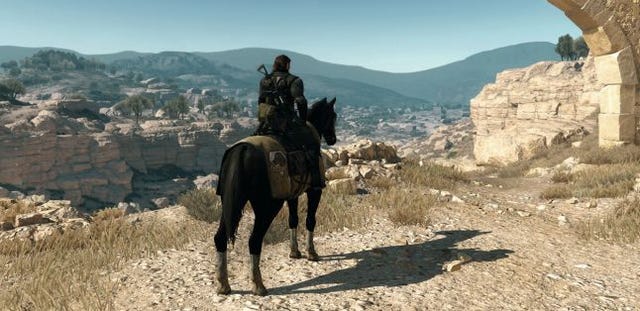
Featured Blog | This community-written post highlights the best of what the game industry has to offer. Read more like it on the Game Developer Blogs or learn how to Submit Your Own Blog Post
Prospect and Refuge
Why do we feel safe in some spaces but anxious in others? This article examines how Metal Gear Solid V integrates player psychology into its level design.

The houses at Çatalhöyük in southeastern Turkey were entered by the roof. People would scurry up a wall, shuffle over to a manhole-sized opening, and climb down into them with a ladder. These buildings weren’t exactly designed for accessibility. Given the ease of use afforded by a door, what could possibly have made the people of Çatalhöyük adopt such an impractical architectural configuration? The settlement was occupied for almost 2,000 years between about 7,500 and 5,700 BC. They had plenty of time to figure something else out. What was it they liked?
The terms ‘prospect’ and ‘refuge’ are used by architects to describe spaces that makes us feel either helpless and vulnerable or safe and secure. Characterized by open areas with little or no cover, prospect spaces allow people to be tracked and followed by an observer. Refuge spaces by contrast are partially enclosed areas which afford clear views from the inside out, but not from the outside in. Prospect spaces include airplane tarmacs, farmer’s fields, and beaches at low tide. Refuge spaces include bunkers, towers, and trenches. The reason why people feel anxious in the former, but calm in the latter is quite simple: survival instincts. Human beings have been conditioned for millennia to be hunters — not prey.

Mountain valleys are quintessential prospect spaces
The concept of prospect and refuge is broadly applicable in level design, but relatively few game designers have to understand it in detail. The dividing line between those who do and those who don’t is almost always genre. Designers working on RPGs like The Witcher 3 probably don’t need to worry so much about it. Designers working on a stealth game like Dishonored, though? Well, they probably do.
Stealth games weave prospect and refuge into their core mechanics. Since the primary aim is to complete your objective without being detected by guards, you of course want to keep far away from prospect spaces wherever possible. But you can’t just stay in refuge spaces. These actually serve a particular purpose: they allow you to observe guard behavior and plan out your next moves. (They also give you a welcome break from the stress of getting spotted).

Stealth games involve sneaking through a maze of prospect and refuge spaces
Prospect and refuge spaces can be worked into most linear environments with enough attention to detail by their designers, but what about open worlds? Games with an open world have to overcome a very specific problem: scale. Putting the same amount of effort into a map that’s many times the size would require enormous amounts of studio time. The developer behind Dishonored, Arkane, endowed its environments with lavish detail, but Dunwall is definitely not an open world. How then did Kojima work with prospect and refuge in Metal Gear Solid V?

Metal Gear Solid V is far too large to build prospect and refuge spaces into it by hand
Rather than building prospect and refuge spaces into the entire game world by hand, Kojima simply carved out several discrete areas of Metal Gear Solid V’s massive maps. Each one of them received a high level of detail. In between these areas are empty spaces where players can roam around without worrying too much about detection. Well, they’re not completely empty: supply trucks and patrol cars regularly come barreling down the road. Check points can also be found at most of the important intersections. Some places are even scanned for activity by helicopters. This helps to make them seem lifelike, but these spaces are mostly just used to separate the primary points of player interest where the story beats play out and the collectibles are hidden.
The Lamar Khaate Palace provides a good example of one such point of interest. Located on the western side of the Northern Kabul map, the area is separated from the nearest points of interest — Yakho Oboo Supply Outpost, Wakh Sind Barracks, Da Wialo Kallai, and Da Shago Kallai — by the sandy Leke Desert. There are check points guarding the roads to the north and south. Drop a few mines or a C-4 charge anywhere along most of these and you can ambush the vehicles traveling around on them. There should be one passing by every few minutes. (You can also capture them with a Fulton Device).

The Lamar Khaate Palace is surrounded by the Leke Desert
Inside these discrete areas of its massive game world, Metal Gear Solid V is structurally similar to most other stealth games.
Spoiler alert: the following two paragraphs contain minor mid-game spoilers.
In line with games like Dishonored, Metal Gear Solid V uses prospect space to create intense feelings of tension. Snake is easily spotted by guards whenever he wanders too far from cover, so players learn to instinctively avoid these areas. But sometimes the game forces you into them. This mechanical tension is even coupled with narrative tension at several points throughout the main storyline. Coming under fire by the sniper Quiet, Snake at one point has to sneak through the Aabe Shifap Ruins on his way to the Afghanistan Central Base Camp. (She’ll join your team back home at Mother Base if you can get in close enough to knock her out). Traversing this area is rather tricky: it’s a bowl-shaped space with only a handful of narrow columns and broken walls for cover. Quiet can scope you out pretty quickly from any number of high ledges.

The Aabe Shifap Ruins are in a deep physical depression
Sneaking past Quiet is only the beginning: Snake’s real objective is actually a bit further up the road. Similar in many ways to the Aabe Shifap Ruins, the Afghanistan Central Base Camp forces players into another prospect space. Surrounded on every side by tall mountains, the area mainly consists of helicopter pads and hangars, but a few barracks are also to be found along its eastern edge. The guards are pretty much everywhere. Some are even equipped with Walker Gears. There isn’t really an easy way through this area: players just have to methodically plan their movements and try to stay hidden. (Waiting until dusk helps a little, too).

The Afghanistan Central Base Camp is mostly prospect space
Similar to its treatment of prospect space, Metal Gear Solid V uses the concept of refuge in ways that should be familiar to most fans of the stealth genre. Refuge spaces are basically safe spots where guard movements can be observed. Knowing that you can’t easily be spotted gives them a certain calming effect which makes for a nice rhythm as you dart through adjacent prospect spaces. Mission objectives are often placed in these areas to provide a believable segue into a cutscene or a few minutes of peace to figure out what needs to be interacted with.
Points of interest like the Aabe Shifap Ruins and the Afghanistan Central Base Camp are mostly prospect space, but the game world also contains less daunting areas. Da Ghwandai Khar is one of these. This village in the middle of the Northern Kabul map is a collection of tightly-packed buildings with few open spaces. Guards periodically roam through its narrow streets. Infiltrating Da Ghwandai Khar isn’t especially hard because there’s always a nearby hiding spot. Take a turn at the closest corner and slip into the shadows if you ever get caught. Many of its buildings have a collapsed wall or two, so you can even observe some of the guards from a safe distance before closing in on your main target: Kazuhira Miller. (Hideo Kojima appears in Da Ghwandai Khar as well, but only after you’ve rescued Miller). Getting back out is no more difficult than getting in.

Da Ghwandai Khar has lots of refuge spaces
What then was Kojima’s take on prospect and refuge space in Metal Gear Solid V? Apart from dividing its massive open world into local areas, the chosen approach wasn’t fundamentally different from other stealth games. In other words, the idea was to pepper places like the Aabe Shifap Ruins, the Afghanistan Central Base Camp, and Da Ghwandai Khar with a high density of prospect and refuge spaces. But these weren’t evenly distributed. Even just looking at these three areas, it’s pretty obvious that some points of interest are easier to sneak into than others.
While Metal Gear Solid V may not have revolutionized the stealth genre, the game remains an exceptional accomplishment. Kojima’s work tapped into something very primal with a high degree of skill and finesse: human survival instincts. The concept of prospect and refuge was pivotal in this.
This article was reproduced from "Prospect and Refuge," posted to SlowRun on February 24, 2018.
Read more about:
Featured BlogsAbout the Author(s)
You May Also Like







.jpeg?width=700&auto=webp&quality=80&disable=upscale)








